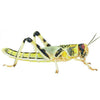
Care Guide: Selecting the Right Feeder Insects for Your Reptile
, by Daniel Davies, 3 min reading time

, by Daniel Davies, 3 min reading time
Feeding your reptile the right diet is crucial for its health and well-being. As a reptile owner, choosing the appropriate feeder insects can be a daunting task, given the variety of options available. In this guide, we’ll break down the key factors to consider when selecting feeder insects and provide insights into the most popular options for your reptile.
Before selecting feeder insects, it’s essential to understand your reptile’s dietary preferences:
Carnivorous Reptiles: Require a diet consisting solely of animal protein, including insects.
Omnivorous Reptiles: Need a mix of insects and plant-based foods.
Herbivorous Reptiles: Primarily eat plants but may occasionally benefit from insect protein during certain life stages.
Knowing your reptile’s species and age will help you determine its specific nutritional needs.
Here’s a breakdown of the most commonly used feeder insects, along with their benefits and drawbacks:
Benefits: Affordable, widely available, and high in protein. Their active movement stimulates natural hunting behavior in reptiles.
Drawbacks: Can be noisy and have a short lifespan. Proper gut-loading is essential for maximum nutrition.
Benefits: Easy to store and long-lasting. Suitable for a variety of reptiles.
Drawbacks: Low in calcium and high in fat, which can lead to nutritional imbalances if overfed.
Benefits: High in protein, low in fat, and odor-free. They don’t jump or fly, making them easier to handle.
Drawbacks: Higher cost compared to crickets. May require a dedicated setup for breeding.
Benefits: Larger size makes them ideal for bigger reptiles. Rich in protein and fats.
Drawbacks: High-fat content requires moderation. Their tough exoskeleton can be harder to digest for some reptiles.
Benefits: Naturally high in calcium, reducing the need for supplementation. Excellent for growing and breeding reptiles.
Drawbacks: More expensive and less active, which might not engage natural hunting instincts as much.
Benefits: High in protein and calcium, making them an excellent staple feeder. They are soft-bodied and easy to digest, suitable for reptiles of all sizes.
Drawbacks: Require specific care and diet to maintain their quality as feeders.
Benefits: A treat option due to their high-fat content. Useful for underweight reptiles or those needing extra energy.
Drawbacks: Should be fed sparingly as they can lead to obesity.
Nutritional Value: Select insects with a balanced ratio of protein, fat, and calcium.
Size: Ensure the insect size matches your reptile’s needs; insects should be no larger than the space between your reptile’s eyes.
Availability: Choose insects that are easy to source locally or online.
Variety: Offering a mix of insects helps prevent nutritional deficiencies and keeps your reptile engaged.
Gut-Loading: Feed insects nutrient-rich foods 24-48 hours before offering them to your reptile.
Calcium Supplementation: Dust feeder insects with calcium powder to prevent metabolic bone disease, especially for species with high calcium needs.
Quarantine New Insects: Prevent potential parasites by keeping new batches of insects separate for a few days before feeding them to your reptile.
Remove Uneaten Insects: Leftover insects can stress your reptile or cause injury.
Observe Feeding Behavior: Monitor your reptile to ensure it’s eating the insects and not showing signs of rejection or difficulty.
Choosing the right feeder insects is key to ensuring your reptile’s health and happiness. By understanding your reptile’s dietary needs, exploring the variety of feeder insects available, and practicing proper feeding techniques, you’ll be well on your way to providing optimal care. Remember, a varied diet is the foundation of a thriving reptile!
Stay tuned for more care guides to keep your reptilian companions happy and healthy!